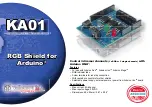
NO:
W90P710 Programming Guide
VERSION:
2.1
PAGE:
92
The above information is the exclusive intellectual property of Winbond Electronics and shall not be disclosed,
distributed or reproduced without permission from Winbond.
Table No.: 1200-0003-07-A
•
ClearPortEnable
– write ‘1’ to bit 0 to clear the
PortEnableStatus
bit
•
SetPortEnable
– write ‘1’ to bit 1 to set the
PortEnableStatus
bit
•
SetPortSuspend
– write ‘1’ to bit 2 to clear the
PortSuspendStatus
bit
•
ClearSuspendStatus
– write ‘1’ to bit 3 to clear the
PortSuspendStatus
bit
•
SetPortReset
– write ‘1’ to bit 4 to set port reset signaling
•
SetPortPower
– write ‘1’ to bit 8 to set the
PortPowerStatus
bit
•
ClearPortPower
– write ‘1’ to bit 9 to clear the
PortPowerStatus
bit
You can get the current status of the
Root Hub
port by reading the following bits :
•
CurrentConnectStatus
– bit 0, reflect the current connect status of the
Root Hub
port
•
PortEnableStatus
– bit 1, indicate whether the port is enabled or disabled
•
PortSuspendStatus
– bit 2, indicate the port is suspended or not
•
PortResetStatus
– bit 4, indicate the
Root Hub
is asserting reset signal on this port
•
PortPowerStatus
– bit 8, reflect the port’s power status
•
LowSpeedDeviceAttached
– bit 9, indicate the speed of the device attached to this port
The following bits indicate the change of status bits. Write ‘1’ to these bits will clear the events :
•
ConnectStatusChange
– bit 16, indicate the connect or disconnect events
•
PortEnableStatusChange
– bit 17, set when hardware event clear the
PortEnableStatus
bit
•
PortSuspendStatusChange
– bit 18, set when the full resume sequence has been
completed
•
PortResetStatusChange
– bit 20, set at the end of the 10-ms port reset signal
6.5.8.4
Virtual Root Hub
Obviously, the
Root Hub
control is quite different from a hub device. The hardware dependent
parts of
Root Hub
will increase the complexity of implementing the USB Driver. Thus, to make the
Root Hub
appear as a normal hub device seems be a better solution. To accomplish this,
HCD
must















































